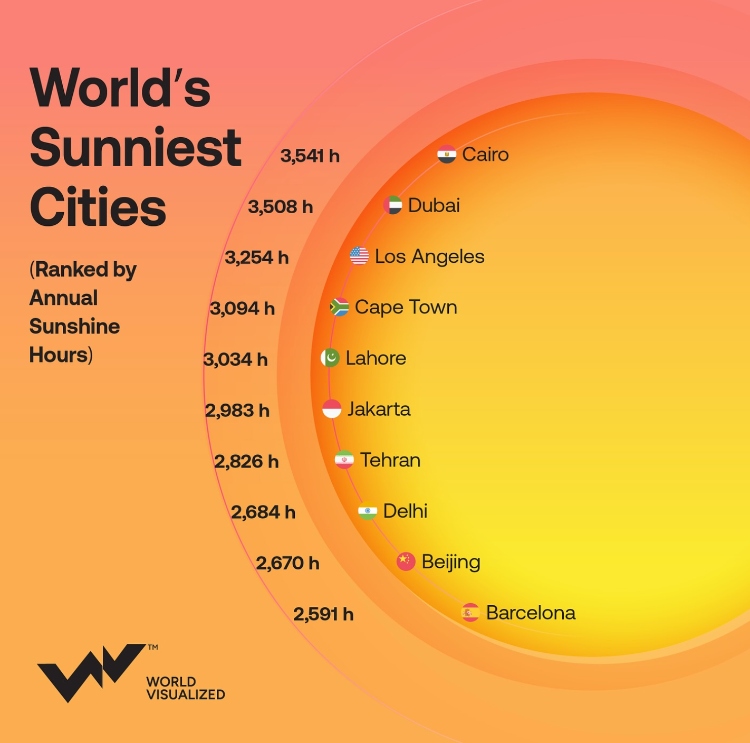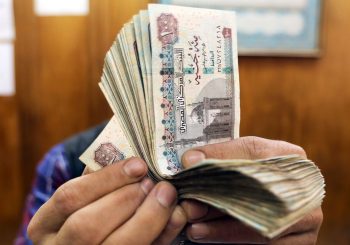Cairo has claimed the spotlight as the sunniest city in the world, according to World Visualized, outshining notable contenders such as Dubai, Los Angeles, Cape Town, Lahore, Jakarta, Tehran, Delhi, Beijing, and Barcelona.
Cairo, Dubai, and Los Angeles experience some of the highest annual sunshine hours, thanks to their geographical locations and climates.
Predominantly situated in or near desert regions, these cities benefit from dry climates and low rainfall, resulting in a greater number of sunny days.
For instance, Cairo boasts 3,541 hours of sunshine each year, while Dubai closely follows with 3,508 hours. Even Los Angeles, known for its Mediterranean climate, enjoys approximately 3,254 hours of sunshine annually.

This distinction is not merely a weather report; it carries profound implications for the health and wellness of its residents. With 3,541 hours of sunlight each year, understanding the effects of this abundant solar exposure is essential for Egyptians.
The Bright Side: Benefits of Sunshine
Sunshine is often celebrated for its mood-lifting qualities. Exposure to sunlight stimulates the production of serotonin, a neurotransmitter that enhances mood and helps combat anxiety and depression according to a 2019 Healthline article medically reviewed by Timothy J. Legg, PhD, PsyD.
Furthermore, sunlight is a natural source of Vitamin D, which plays a crucial role in bone health, and immune function. For a city as bustling and vibrant as Cairo, these benefits are invaluable, contributing to the residents’ well-being and quality of life.
The Dark Side: Risks of Overexposure
However, the sun’s rays can also pose significant risks, particularly for skin health. Prolonged exposure to ultraviolet (UV) radiation can lead to skin damage, premature aging, and an increased risk of skin cancer according to the American Cancer Society.
Moreover, the harsh climate can exacerbate these issues, leading to dehydration and skin irritation. Therefore, understanding how to protect oneself from the sun’s harmful effects is crucial.
In Egypt, there was a 2022 study conducted by professors Dalia A. El-Shafei and Randa M. Said. The study focused on 128 farmers in the Zagazig district, Sharkia Governorate, with an aim to assess sun exposure-related health hazards and evaluate a sun safety intervention.
Results showed that 69 percent of participants had a moderate risk for skin cancer, 77.3 percent had a history of photokeratitis (a painful eye condition caused by direct exposure to the ultraviolet rays from the sunlight) and 43 percent reported poor eyesight, with a significant improvement in sun safety knowledge and behaviors after the intervention, including protective clothing and reducing direct sun exposure.
Essential Precautions for Skin Health
To maintain skin health, it’s crucial to apply sunscreen with a Sun Protection Factor (SPF) of at least 30, reapplying every two hours or after swimming or sweating is essential as per Johns Hopkins University.
Wearing protective clothing like long sleeves and wide-brimmed hats, along with fabrics that have UV protection, can also reduce sun exposure.
It’s also important to seek shade, especially during peak sunlight hours (10 AM to 4 PM) to minimize exposure, and stay hydrated by Drinking lots of fluids to prevent skin dryness and maintain elasticity.
Regular dermatological check-ups are essential for early detection of any skin damage that can be caused by sun exposure.
While Cairo’s title as the sunniest city in the world brings with it a wealth of health benefits, it also underscores the importance of sun safety and skin health awareness.
By adopting proactive measures and educating themselves about the risks and benefits, Egyptians can enjoy the best of their sunny environment while safeguarding their well-being.







Comments (0)